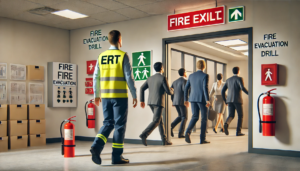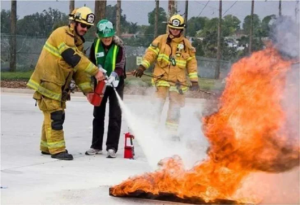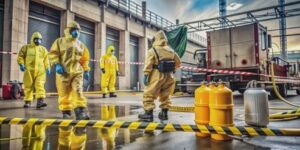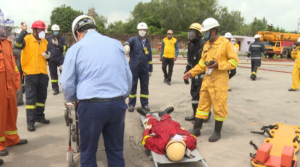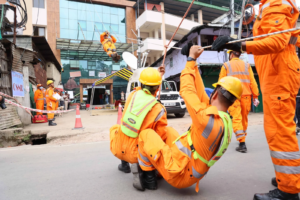Ensuring workplace safety and preparedness for emergencies is a critical responsibility for organizations across industries. The implementation of an Emergency Response Team (ERT) and conducting regular mock drills play a pivotal role in mitigating risks, safeguarding lives, and protecting assets
What Is an Emergency Response Team (ERT)?
An Emergency Response Team is a group of trained individuals designated to respond promptly and effectively to various emergencies, such as fire outbreaks, chemical spills, natural disasters, or medical incidents. These teams are equipped with the knowledge and tools required to manage crises until professional help arrives.
What Are Mock Drills?
Mock drills are simulated emergency scenarios conducted to test the readiness and efficiency of the Emergency Response Team and the facility’s overall emergency protocols. These drills provide a practical platform for employees and ERT members to rehearse their roles in a controlled environment.
Common Scenarios for ERT and Mock Drills
- Fire outbreaks
- Hazardous material spills
- Earthquakes
- Medical emergencies
Case Study: Effective Implementation of ERT and Mock Drills
Recent industrial incidents in India have underscored the critical importance of robust Emergency Response Teams (ERTs) and regular mock drills. Deficiencies in these areas have been identified as root causes in several cases:
1.Atchutapuram Pharmaceutical Factory Explosion (August 2024):
- Incident: An explosion at the Escientia Advanced Sciences pharmaceutical facility in Atchutapuram, Andhra Pradesh, resulted in at least 18 fatalities and 41 injuries.
- Root Cause Analysis: Preliminary investigations suggest that inadequate emergency preparedness and lack of effective ERTs contributed to the high casualty rate. The absence of regular mock drills may have hindered timely and coordinated response efforts. [ Source ]
2.Virudhunagar Firecracker Factory Explosions (February and June 2024):
- Incident: Two separate explosions occurred in firecracker manufacturing units in Virudhunagar district, Tamil Nadu. The first, in February, resulted in 10 deaths and multiple injuries; the second, in June, led to 4 fatalities and 1 injury.
- Root Cause Analysis: Both incidents were attributed to mishandling of explosive materials and inadequate safety measures. The lack of emergency preparedness and absence of regular mock drills likely delayed response times, exacerbating the impact. [ Source ]
3.Fire at Tata Electronics Plant (September 2024):
- Incident: A fire broke out at a Tata Electronics facility in Tamil Nadu, which manufactures components for Apple iPhones, halting production.
- Root Cause Analysis: The exact cause remains under investigation. However, the incident highlights the need for effective emergency response plans and regular mock drills to ensure swift action during such events. [ Source ]
The lack of effective Emergency Response Teams (ERTs) and the absence of regular mock drills were key contributing factors in many of these recent incidents in India. These case studies underscore the importance of having well-trained emergency teams, clear protocols, and regular drills to ensure timely and effective responses to potential disasters. The Indian government, along with private organizations, has been increasing efforts to enforce safety regulations, implement ERTs, and prioritize emergency preparedness to prevent further loss of life and property in future emergencies
Key Benefits of ERT and Mock Drills
Emergencies can strike without warning. Regular mock drills ensure that employees and the ERT are familiar with evacuation routes, emergency equipment, and communication protocols, reducing panic and confusion during real incidents.
A well-trained ERT can react swiftly, minimizing the impact of emergencies. Mock drills help identify potential delays and streamline processes to ensure a faster response time in actual scenarios.
Effective emergency responses can prevent extensive damage to property and ensure quicker resumption of operations, safeguarding the organization’s financial stability and reputation.
By simulating emergencies, organizations can identify and address gaps in their safety protocols, reducing the likelihood of accidents and ensuring the facility’s resilience against unforeseen events.
Knowing that their organization prioritizes safety and has robust emergency plans boosts employee morale and confidence. Mock drills also empower employees to act responsibly during emergencies.
Many regulatory frameworks (The Factories Act, 1948, The National Building Code of India (NBC), 2016, Petroleum and Natural Gas Regulatory Board (PNGRB) Guidelines, Bureau of Indian Standards (BIS)) mandate the establishment of an ERT and regular mock drills as part of workplace safety standards. Adhering to these requirements demonstrates an organization’s commitment to safety and helps avoid legal penalties.
Why Choose NIST Global for ERT and Mock Drill Training?
- Competent Trainers: Our trainers are industry-certified HSE professionals with extensive experience.
- Customized Training Programs: Tailored solutions to meet the specific needs of your facility.
- Practical and Theoretical Sessions: Hands-on training ensures real-world applicability.
- Compliance Assurance: Our programs align with national and international safety standards.
Next Steps
For detailed information about NIST Global Emergency Response Team services and Mock Drill offerings, I recommend:
1.Visiting the Provided Links:
2.Contacting NIST Global Directly:
Reach out via our customer service to inquire about specific services, pricing, and how can tailor solutions to your organization’s needs.
3.Requesting a Consultation:
Conclusion
Investing in an Emergency Response Team and conducting regular mock drills is not just a legal obligation but a moral responsibility for organizations. By prioritizing safety, businesses can ensure the well-being of their employees, protect assets, and foster a culture of preparedness.
Ensuring robust emergency preparedness is vital for the safety and resilience of any organization. Leveraging expert services like those potentially offered by NIST Global can significantly enhance your ability to respond effectively to unforeseen events.
FAQs
Q: How often should mock drills be conducted?
A: It is recommended to conduct mock drills at least twice a year or as required by local regulations.
Q: Who should be part of the ERT?
A: ERT members typically include employees trained in first aid, fire safety, hazardous material handling, and evacuation procedures.
Q: Can mock drills disrupt operations?
A: While mock drills may cause temporary disruptions, they are essential for long-term safety and operational continuity.


